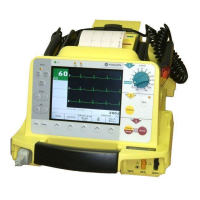Manual Defibrillation / Non-Synchronized Defibrillation
18 Marquette Responder® 3000 227 490 02-C
4 Manual Defibrillation
4.1 Defibrillator Application Guidelines
Observe the following guidelines to ensure
successful and safe defibrillation. Otherwise the
lives of the patient, the user and bystanders are in
danger.
Warning
-
Defibrillating a patient with normal heart
rhythm may induce ventricular fibrillation.
-
Position the patient flat on a hard surface
where he is electrically insulated. The patient
must not be allowed to come into contact with
metal parts, e.g., bed or litter, to prevent un-
wanted pathways for the defibrillation current
which may endanger the assistants. For the
same reason, do not position the patient on
wet ground (rain, accident in swimming pool).
Do not allow the defibrillation electrodes to
come into contact with other electrodes or
metal parts which are in contact with the pa-
tient.
The patient's chest must be dry, because
moisture can cause unwanted pathways for
the defibrillation current.
After use of flammable skin cleansing agents,
wait until they have completely dried.
-
The operator and all assistants must be briefed
regarding the preparations for and execution
of defibrillation.
All tasks must be clearly assigned.
Immediately prior to the shock
- interrupt heart massage and artificial
respiration,
- disconnect tube connections, and
- warn bystanders.
-
Ensure that no conductive connection between
the patient and bystanders exists during defi-
brillation.
-
Before delivering the shock, verify that the
charged and selected energies are the same.
-
Shock Hazard — Always switch off the device
before exchanging the defibrillation elec-
trodes.
-
Pacemaker Patients — Defibrillating a patient
with an implanted pacemaker is likely to im-
pair the pacemaker function or cause damage
to the pacemaker.
For this reason
- select the smallest energy level possible for
the application,
- do not apply the defibrillation paddles in the
vicinity of the pacemaker electrodes,
- have an external pacemaker at hand,
- check the implanted pacemaker for proper
functioning as soon as possible after the
shock.
Caution
-
Equipment Damage — Disconnect transduc-
ers and devices that are not defibrillation-
proof from the patient before delivering the
shock.
-
Equipment Damage — Do not defibrillate the
patient with a second defibrillator, while defi-
brillation electrodes (paddles, pads) of the first
device are applied.
If the use of a second defibrillator is inevita-
ble, disconnect the electrodes from the first
device or remove them from the patient.

